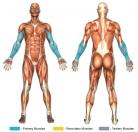Hammer Curls (Dumbbell)
Performance Description
- Stand or sit with your arms at your sides.
- Grasp the weight with your forearm pronated (palms facing inward). Note: The curling motion can be performed three ways: alternating arms, both arms at the same time, or one arm at a time.
- Curl the weight upward (keeping the palm facing inward), while exhaling throughout the movement.
- Lower the weight slowly, inhaling throughout the movement.
- Repeat steps 3-4 for as many sets as are desired. (Sets should generally fall between 3 to 6 with 6-12 repetitions).
Various Methods of Exercise: Dumbbell, Cable (with the rope attachment)
Primary Muscle(s)
Biceps (Biceps Brachii: Long 'Outer' Head)
Biceps (Biceps Brachii: Short 'Inner' Head)
Forearms (Brachioradialis)
Secondary Muscle(s)
Biceps (Brachialis)
Further Clarification
Hammer curls do a smashing job of isolating the Brachioradialis and contribute to overall mass and inner biceps head thickness.
The curling motion can be performed three ways: alternating arms, both arms at the same time, or one arm at a time.
Hammer curls allow for self-spotting, if one arm is exercised at a time. To self-spot on hammer curls, simply use your free hand to gently help (via touch spot) the working arm to raise the weight when it becomes too difficult to lift unassisted.
Things To Look Out For
Some people may develop elbow (tendon) pain if they do curls incorrectly. Three things to remember to greatly reduce the chance of elbow injury are:
- Always control the weight, especially on the down movement. Letting the weight drop as the elbow reaches the bottom "locked" position causes tremendous stress on it that will likely result in injury.
- Keep your wrists straight (neutral). It is in this manner that maximum biceps stress will be achieved. Bending your wrist in either direction (upward or downward) removes focus from the intended muscle, the biceps, and creates vulnerability to injury (elbow or wrist).
- Keep your elbows at your side throughout the movement, especially if you are a novice. Many people can raise their elbows (forward) at the top of the curl movement without becoming injured, though by raising the elbows the anterior deltoids become far more involved. If you are looking for a shoulder workout, then shoulder exercises better serve this purpose. However, there are experts who claim that raising the elbow(s) forward allows for a fuller contraction of the biceps. Use good judgment when determining whether or not to perform curls this way.
Level
Beginner
Exercise Position(s)
Standing, Sitting
Considered An Exercise In The Following Categories





